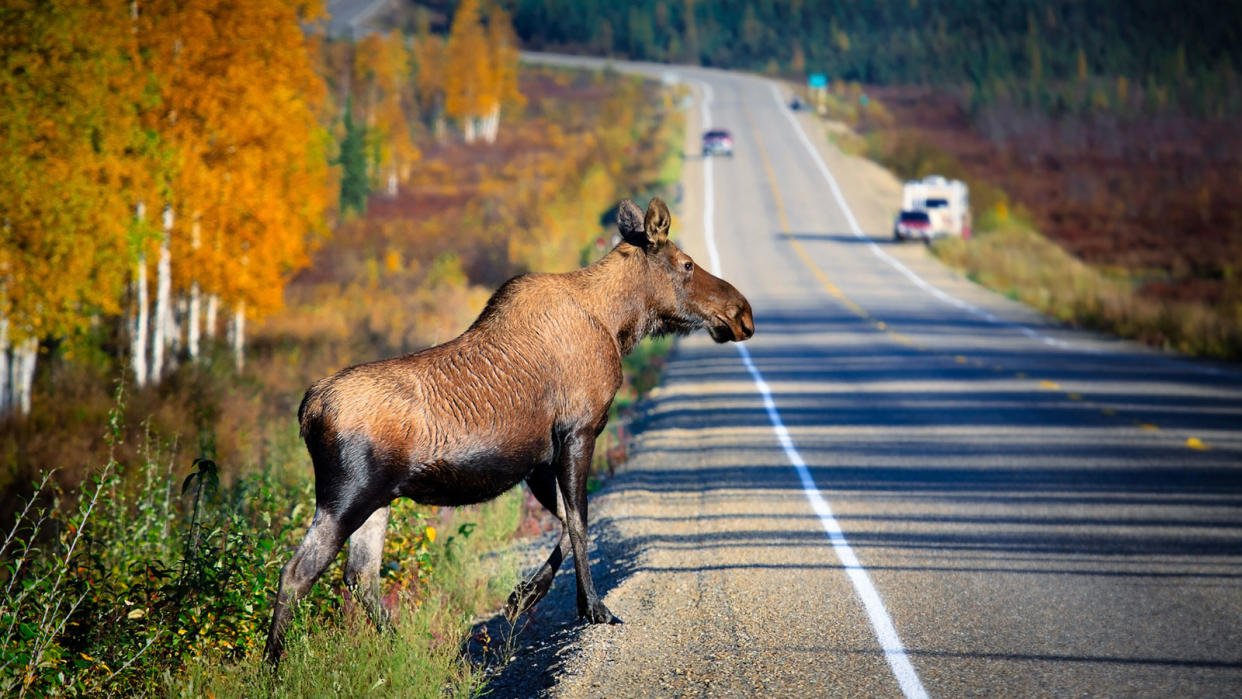Why Are Moose Dangerous, Even More Threatening Than Bears?

According to the Alaska Department of Fish and Game, more people in the state are injured by moose than by bears each year. Fortunately, people rarely die as a result of moose encounters. But why, exactly, are moose dangerous, and what can you do to avoid bad moose behavior?
Let's take a closer look at what makes North America's tallest animal such a threat.
Moose Basics
The largest species of the deer family, moose can grow to be 7 feet (2 meters) tall and weigh as much as 1,800 pounds (820 kilograms). Females are called cows and males are called bulls.
Alaskan moose are the biggest in the world. But their size betrays their generally passive demeanor. Feeding off plants and tree bark, these herbivores munch on willows, birches and grasses by the pound. During the barren winter, when moose can't source these natural foods, Anchorage residents watch them turn to eating trash.
In March and April, the winter food supply in the wild grows scarce, and hungry moose are more likely to lumber into the city in higher numbers.
Moose vs. Bear Attacks
Although moose aren't more dangerous than bears in terms of their behavior, they pose a greater threat of injuring you simply because of their large numbers close to certain habited areas.
In Alaska, the moose population is between 175,000 and 200,000. Moose outnumber bears (the state has about 100,000 black bears and 30,000 brown bears) and are responsible for wounding five to 10 people in the state annually. Meanwhile, on average, three to four people are hospitalized each year as a result of a bear attack.
Despite the incidence rates, moose actually fear humans, and moose aggression toward people is not natural behavior.
When Moose Attack
In moose country, the number of moose attacks spikes in September and October, during mating season and the early spring when mothers are protecting their young calves. However, moose often do not confront people unless you provoke them. Moose especially dislike dogs because they run up and bark at them.
Hunger can also make moose more dangerous and increase the odds of moose attacks. When they're hungry, they'll return to a place where they were once given food or found food, and they may attack if the food isn't there again.
To lower the chance of food-related attacks, Alaska has made moose feeding a misdemeanor that carries a maximum penalty of one year in prison and a $10,000 fine.
Moose Attacks: How to Avoid One and What to Do
To avoid moose attacks, don't throw anything at them, and keep dogs away. Don't feed moose, even from a distance.
If a cow moose or bull moose charges at you, run to avoid getting trampled. Hide behind the nearest tree, building or car if you don't have time to get inside. Although moose can outrun humans at their top speeds, many times, they won't chase you far if you can run away to a safe distance.
If you don't get away fast enough, and a moose knocks you down, don't struggle. Curl into the fetal position and cover your head with your arms. Trying to move or beat it off will only cause the moose to continue kicking and stomping you.
If you see one that isn't approaching, your best bet is to avoid it and allow it to move out of your way. However, if you notice its hairs raised, head down and ears back, that's your cue to hightail it in the opposite direction.
Moose on the Roads of Alaska
A majority of moose-related injuries in Alaska take place on the roads. Their presence on Alaskan roads and highways contributes to about 500 moose accidents each year. This is the highest anywhere in North America.
However, according to the Alaska Department of Transportation, the odds of dying in a moose-related accident are 0.5 percent — just half of 1 percent.
These accidents happen in spite of many efforts to keep moose off the Alaskan roads. To help maintain moose-free roads, there are wire fences along highways with high traffic. There are also moose underpasses beneath roads to allow for safe crossing and one-way moose gates.
But drivers and passengers aren't the only ones suffering from situations in which moose wander onto roads. About 120 moose die each year from car crashes in Anchorage, and nearly 800 die across the entire state.
This situation is not unique to Alaska. Car crashes resulting from deer species total 2.1 million annually across the United States. The top state for collisions with wild animals is West Virginia, with a driver's odds being 1 in 38.
Lots More Information
Sources
Alaska Department of Fish & Game. "Driving in Moose Country." (Sept. 18, 2019) https://www.adfg.alaska.gov/index.cfm?adfg=livewith.drivingmoosecountry
Alaska Department of Fish & Game. "What to Do About Aggressive Moose." (Sept. 18, 2019) http://www.wc.adfg.state.ak.us/index.cfm?adfg=aawildlife.agmoose
Alaska Department of Natural Resources. "Bears and You." Division of Parks and Outdoor Recreation. Updated March 24, 2008. (April 7, 2008)http://www.dnr.state.ak.us/parks/safety/bears.htm
Alaska Department of Natural Resources. "Common Sense Survival." Division of Parks and Outdoor Recreation. Updated March 24, 2008. (April 7, 2008)http://www.dnr.state.ak.us/parks/safety/comsense.htm
CBS News. "Alaska's Urban Moose Adjust to Heavy Snow." Jan. 31, 2007. (April 7, 2008) http://www.cbsnews.com/stories/2007/01/31/tech/main2417996.shtml
CNN. "Worst states for auto-deer crashes." Nov. 14, 2006. (April 7, 2008)http://www.cnn.com/2006/AUTOS/11/14/deer_crash/index.html
DuFresne, Jim and Spitzer, Aaron. "Lonely Planet Alaska." Lonely Planet. 2006. (April 7, 2008)http://books.google.com/books?id=b-JDesZWm5gC
National Parks Service. "Bear, Moose & Wolf Warnings." (April 7, 2008)http://www.nps.gov/dena/upload/Bear,%20Moose,%20Wolf%20Warnings.pdf
Smith, Dave. "Don't Get Eaten: The Dangers of Animals that Charge or Attack." 2003. The Mountaineering Books. (April 4, 2008)http://books.google.com/books?id=kpBOpT1oszIC&pg=PA71&dq=alaska+moose+attacks&sig=FSP3CbS8p1j1hdy1OeLXLXlSt_k#PPA71,M1
Stadem, Catherine. "Moose in Our Midst." Alaska. 1994. (April 4, 2008)
Original article: Why Are Moose Dangerous, Even More Threatening Than Bears?
Copyright © 2024 HowStuffWorks, a division of InfoSpace Holdings, LLC, a System1 Company


